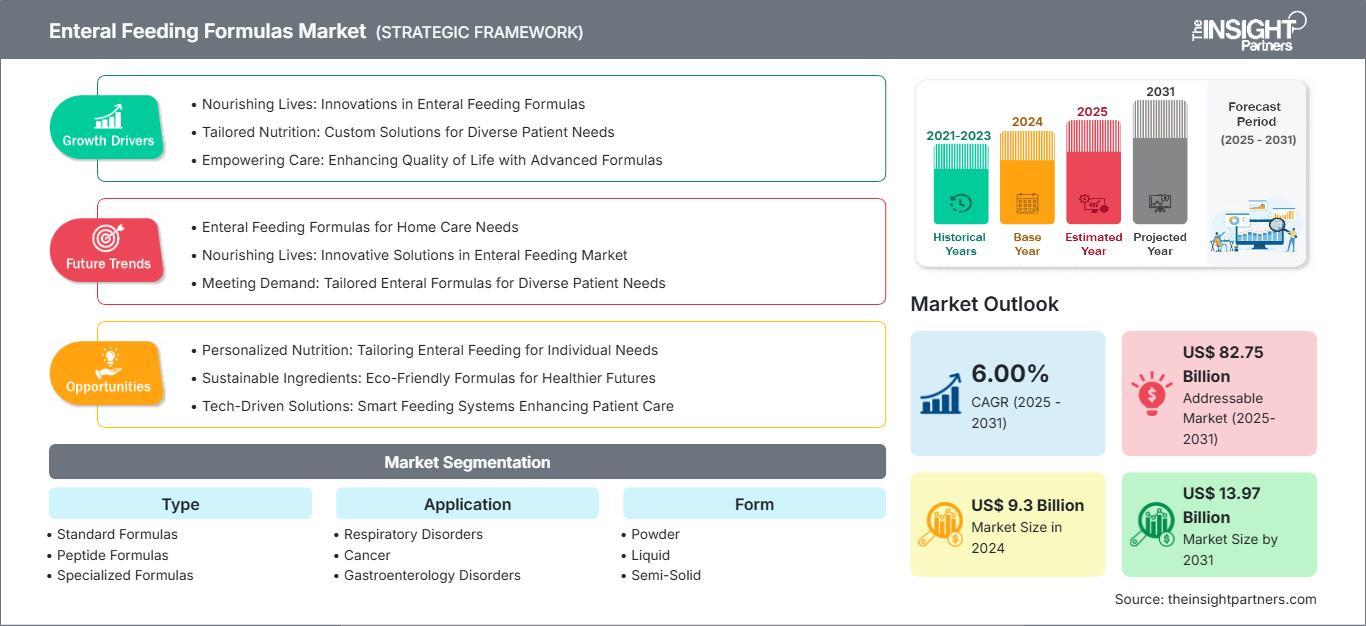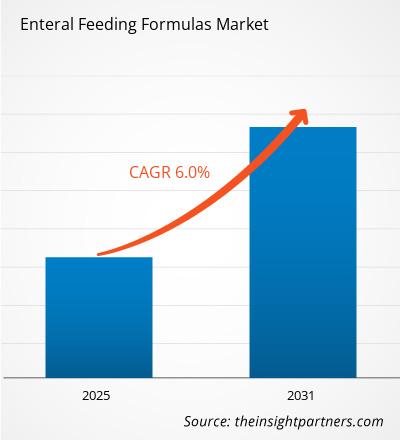من المتوقع أن يسجل سوق تركيبات التغذية المعوية معدل نمو سنوي مركب بنسبة 6.00٪ من عام 2025 إلى عام 2031، مع توسع حجم السوق من 9.3 مليار دولار أمريكي في عام 2024 إلى 13.97 مليار دولار أمريكي بحلول عام 2031.
يُصنّف التقرير حسب النوع (التركيبات القياسية، تركيبات الببتيد، التركيبات المتخصصة)، ويُحلل السوق بشكل أعمق بناءً على التطبيقات (اضطرابات الجهاز التنفسي، السرطان، اضطرابات الجهاز الهضمي، السكري، أمراض الكبد/الكلى، أمراض الأعصاب، ما بعد كوفيد-19). كما يُحلل السوق حسب شكله (مسحوق، سائل، شبه صلب) والفئة العمرية للقطاع (أطفال، بالغون). ويُقدّم تحليلاً شاملاً على المستويات العالمية والإقليمية والوطنية لكل من هذه القطاعات الرئيسية.
يتضمن التقرير حجم السوق وتوقعاته لجميع القطاعات، مع عرض القيم بالدولار الأمريكي. كما يُقدّم إحصاءات رئيسية حول الوضع الحالي للسوق لأبرز الشركات، بالإضافة إلى رؤى حول اتجاهات السوق السائدة والفرص الناشئة.
غرض التقرير
يهدف تقرير "سوق تركيبات التغذية المعوية" الصادر عن "ذا إنسايت بارتنرز" إلى وصف المشهد الحالي والنمو المستقبلي، وأهم العوامل المحفزة، والتحديات، والفرص المتاحة. وسيوفر هذا التقرير رؤى ثاقبة لمختلف أصحاب المصلحة في قطاع الأعمال، مثل:
- مزودي/مصنعي التكنولوجيا: لفهم ديناميكيات السوق المتطورة ومعرفة فرص النمو المحتملة، وتمكينهم من اتخاذ قرارات استراتيجية مستنيرة.
- المستثمرون: لإجراء تحليل شامل للاتجاهات فيما يتعلق بمعدل نمو السوق، والتوقعات المالية للسوق، والفرص الموجودة عبر سلسلة القيمة.
- الهيئات التنظيمية: لتنظيم السياسات ومراقبة الأنشطة في السوق بهدف تقليل الانتهاكات والحفاظ على ثقة المستثمرين ودعم سلامة السوق واستقرارها.
تجزئة سوق تركيبات التغذية المعوية
يكتب
- الصيغ القياسية
- صيغ الببتيد
- الصيغ المتخصصة
طلب
- اضطرابات الجهاز التنفسي
- سرطان
- اضطرابات الجهاز الهضمي
- السكري
- أمراض الكبد/الكلى
- علم الأعصاب
- ما بعد كوفيد-19
استمارة
- مسحوق
- سائل
- شبه صلبة
الفئة العمرية
- أطفال
- بالغ
ستحصل على تخصيص لأي تقرير - مجانًا - بما في ذلك أجزاء من هذا التقرير، أو تحليل على مستوى الدولة، وحزمة بيانات Excel، بالإضافة إلى الاستفادة من العروض والخصومات الرائعة للشركات الناشئة والجامعات
سوق تركيبات التغذية المعوية: رؤى استراتيجية

-
احصل على أهم اتجاهات السوق الرئيسية من هذا التقرير.ستتضمن هذه العينة المجانية تحليل البيانات، بدءًا من اتجاهات السوق وحتى التقديرات والتوقعات.
عوامل نمو سوق تركيبات التغذية المعوية
- تغذية الحياة: ابتكارات في تركيبات التغذية المعوية
- التغذية المُخصصة: حلول مُخصصة لتلبية احتياجات المرضى المتنوعة
- تمكين الرعاية: تحسين جودة الحياة باستخدام تركيبات متقدمة
اتجاهات مستقبل سوق تركيبات التغذية المعوية
- تركيبات التغذية المعوية لاحتياجات الرعاية المنزلية
- تغذية الحياة: حلول مبتكرة في سوق التغذية المعوية
- تلبية الطلب: تركيبات معوية مصممة خصيصًا لتلبية احتياجات المرضى المتنوعة
فرص سوق تركيبات التغذية المعوية
- التغذية الشخصية: تصميم التغذية المعوية وفقًا للاحتياجات الفردية
- مكونات مستدامة: تركيبات صديقة للبيئة لمستقبل أكثر صحة
- الحلول القائمة على التكنولوجيا: أنظمة التغذية الذكية تُحسّن رعاية المرضى
رؤى إقليمية حول سوق تركيبات التغذية المعوية
قام محللو شركة "ذا إنسايت بارتنرز" بشرح شامل للاتجاهات الإقليمية والعوامل المؤثرة في سوق تركيبات التغذية المعوية خلال فترة التوقعات. ويناقش هذا القسم أيضًا قطاعات سوق تركيبات التغذية المعوية ونطاقها الجغرافي في أمريكا الشمالية، وأوروبا، وآسيا والمحيط الهادئ، والشرق الأوسط وأفريقيا، وأمريكا الجنوبية والوسطى.
نطاق تقرير سوق تركيبات التغذية المعوية
| سمة التقرير | تفاصيل |
|---|---|
| حجم السوق في عام 2024 | 9.3 مليار دولار أمريكي |
| حجم السوق بحلول عام 2031 | 13.97 مليار دولار أمريكي |
| معدل النمو السنوي المركب العالمي (2025 - 2031) | 6.00% |
| البيانات التاريخية | 2021-2023 |
| فترة التنبؤ | 2025-2031 |
| القطاعات المغطاة |
حسب النوع
|
| المناطق والبلدان المغطاة |
أمريكا الشمالية
|
| قادة السوق وملفات تعريف الشركات الرئيسية |
|
كثافة اللاعبين في سوق تركيبات التغذية المعوية: فهم تأثيرها على ديناميكيات الأعمال
يشهد سوق تركيبات التغذية المعوية نموًا سريعًا، مدفوعًا بتزايد طلب المستخدمين النهائيين نتيجةً لعوامل مثل تطور تفضيلات المستهلكين، والتقدم التكنولوجي، وزيادة الوعي بفوائد المنتج. ومع تزايد الطلب، تعمل الشركات على توسيع عروضها، والابتكار لتلبية احتياجات المستهلكين، والاستفادة من الاتجاهات الناشئة، مما يعزز نمو السوق.

- احصل على نظرة عامة على أهم اللاعبين الرئيسيين في سوق تركيبات التغذية المعوية
نقاط البيع الرئيسية
- التغطية الشاملة: يغطي التقرير بشكل شامل تحليل المنتجات والخدمات والأنواع والمستخدمين النهائيين لسوق تركيبات التغذية المعوية، مما يوفر مشهدًا شاملاً.
- تحليل الخبراء: تم تجميع التقرير على أساس الفهم العميق لخبراء الصناعة والمحللين.
- المعلومات الحديثة: يضمن التقرير أهمية الأعمال التجارية بسبب تغطيته للمعلومات الحديثة واتجاهات البيانات.
- خيارات التخصيص: يمكن تخصيص هذا التقرير لتلبية متطلبات العملاء المحددة وتلبية استراتيجيات العمل بشكل مناسب.
لذا، يُمكن لتقرير البحث حول سوق تركيبات التغذية المعوية أن يُسهم في تمهيد الطريق لفهم سيناريوهات هذه الصناعة وآفاق نموها. ورغم وجود بعض المخاوف المُبررة، إلا أن فوائد هذا التقرير الإجمالية تفوق عيوبه.
- التحليل التاريخي (سنتان)، سنة الأساس، التوقعات (7 سنوات) مع معدل النمو السنوي المركب
- تحليل PEST و SWOT
- حجم السوق والقيمة / الحجم - عالمي، إقليمي، بلد
- الصناعة والمنافسة
- مجموعة بيانات إكسل
التقارير الحديثة
شهادات العملاء
سبب الشراء
- اتخاذ قرارات مدروسة
- فهم ديناميكيات السوق
- تحليل المنافسة
- رؤى العملاء
- توقعات السوق
- تخفيف المخاطر
- التخطيط الاستراتيجي
- مبررات الاستثمار
- تحديد الأسواق الناشئة
- تحسين استراتيجيات التسويق
- تعزيز الكفاءة التشغيلية
- مواكبة التوجهات التنظيمية






















 احصل على عينة مجانية ل - سوق تركيبات التغذية المعوية
احصل على عينة مجانية ل - سوق تركيبات التغذية المعوية